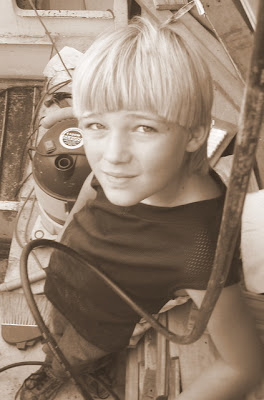
So, here is the Cargo Hold of our boat.... It is aft of the
Forecastle (focsul), and forward of the Main Salon and it is about 16' x 10'. It will eventually serve as our main
head, a library/Guest Cabin, and Tamer's shop.
This picture shows what used to be the base for our wood and glass skylight that fits here. After it's removal, it became clear that they previous owners had intended to 'build' a skylight, but then found one salvaged that would fit the hole. The actual cargo hold cover, although removable, weighs about 600 pounds without the skylight attached. We needed to repair the skylight base, and also the mating surfaces between the deck and the cover.

We rallied up an able bodied crew for the removal of the cover, as we needed to lift it overboard to do the necessary repairs. Here is Olivier using a pry bar to separate the cover from the deck.

Matt was the tag line manager, and part of the muscle behind the whole operation.

Here is the cover breaking free from the deck with the help of my dear husbands brute strength.

We could never have done it without the awesome ground crew! Raoul was the on the ground using the tag lines to steer the cover to the proper spot. Blayde was standing by with a block to place under the first corner to touch down.

Matt, Tamer and Olivier.... It is almost off!

Over the side

Here is Nathalie, coming to the rescue as a needed tag line person.

Woo-Hoo!!! Wow, the pictures make it all look so easy :-) We managed to get away with no parts broken on any of us, or the boat. Oh, yea, that is Deana off to the side offering a helping hand if needed, and as always a beautiful smile.
P.S. I served as photographer for this project due to a newly broken toe....

Blayde doing his first stint as an expert grinding person. We were really proud of his willingness to take on such a difficult task, at his age. It took him 1 1/2 days of work, but his job was to grind the mating surface of the cargo hold to the deck.

Here is a close up shot of him grinding the underside of the lip. Although not pictured,Tamer devised a way to put a grinding disc on upside down to make this job a little easier.
Wow! Look at all that shiny metal!

After osphoing and lightly sanding, I was handed the task of painting 3 coats of
Amerlock onto the surface. It became evident very quickly that a mirror is a must for this type of painting. I really wanted there to be 3 GOOD coats, so that rust could be prevented for as long as possible.

Once the cover was situated on the ground, Tamer began the process of removing the whole upper piece and replacing it with a 2" x 2" piece of angle iron. This is also a good shot of all of the rust that had developed on the outside of that upper portion.

We have been joined by some new steel boat owning neighbors in the boat yard, who happen to have a plasma cutter. The envy of all steel boat owners in the yard :-) Tamer got to try it out on this project, and it saved us a fortune on cutting discs for the grinder. Thanks Marc & Patty of SV Fortuna!

Now, the angle iron is welded in place, the lid has been flipped over, and work has begun on preparing it for ospho and paint.

Here comes the dancing girls..... Oh wait, that is the painting crew.....
In the lower right hand corner of the picture, you can see the mating surface of the cover that meets the deck surface. This was a tricky painting experience to match the need for a mirror up on deck. Behind my legs closest to the ground, you can see the newly attached piece of angle iron that the skylight will fit onto.






























































